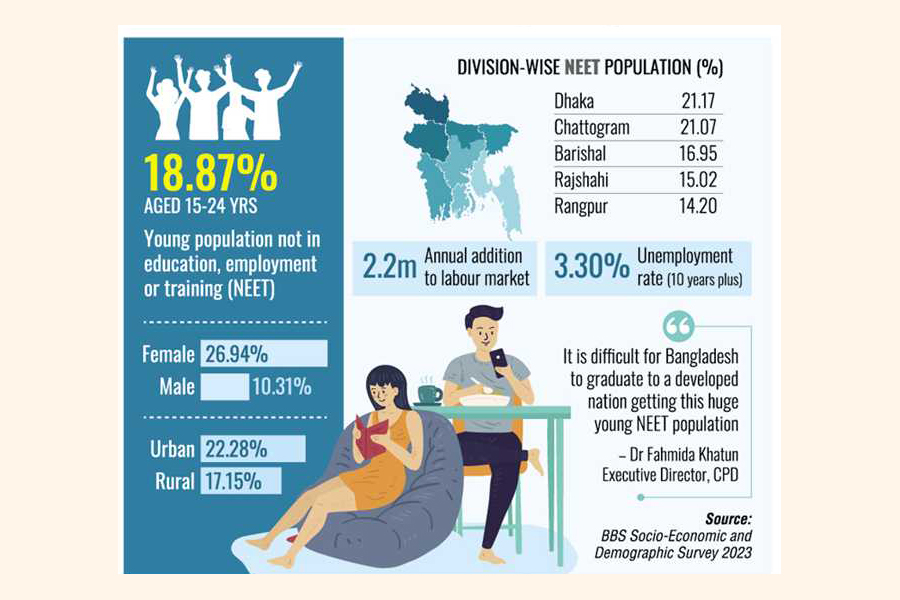
Many in young population in Bangladesh left on lurch
Economy loses as one-fifth youths lack education, employment
FHM HUMAYAN KABIR | Monday, 24 June 2024
About a fifth of Bangladesh's young population is still deprived of education and employment both as per official count, which analysts term alarming for a growing economy.
A total of 18.87 per cent of the young population, aged between 15 and 24 years, are not in education, employment or training (NEET), the Socio-Economic and Demographic Survey 2023 showed.
Of the NEET population on the lurch, females are in a vulnerable position as their number is more than double in count than their male counterparts.

According to the BBS (Bangladesh Bureau of Statistics) survey, the young females who are neither in education nor in employment nor in training are 26.94 per cent.
And the rate of their young male counterparts is 10.31 per cent in the country, the survey data showed.
Bangladesh is one of the countries in the world with millions still unemployed. Every year some 2.2 million people are added to the labour market.
According to the latest socioeconomic and demographic count, the unemployment rate for those in 10 years of age and above in Bangladesh is 3.30 per cent.
The BBS survey has defined NEET individuals as those who were not studying, not engaged in any work for at least one hour in the seven days prior to the headcount and not received any vocational training in the preceding twelve months.
In an apparent paradox, the incidence of NEET population is higher in urban areas than in the rural Bangladesh, the survey report reveals.
"The towns are the home of 22.28 per cent of the young unemployed, non-educated and non-trained population," says the survey report.
The rate of the NEET population in rural areas is 17.15 per cent.
In the NEET population, Dhaka is on top as it has been recorded 21.17 per cent due to higher numbers of young females.
Chittagong is home to the second-largest NEET population in the country as it accounts for 21.07 per cent of the young not in education, employment or training, 2.20 percentage points higher than the national average of 18.87 per cent, the BBS data showed.
The NEET population in Rangpur is the lowest in the country as the rate was counted at 14.20 per cent among the population aged between 15 and 24 years.
Rajshahi and Barishal divisions are in the second and third position in terms of lowest rate of the NEET population.
Rajshahi division holds 15.02 per cent of the NEET population while Barishal division 16.95 per cent.
Meanwhile, the UNESCAP report in January this year showed that Bangladesh has higher percentage of youth NEET population among the Asian nations.
Countries like Bangladesh, Afghanistan, India, Indonesia, Iran, Nepal, Pakistan, Sri Lanka and Turkey, among others, have nearly 20 per cent of NEET young people aged between 15 and 24 years, according to UN ESCAP's 'Asia-Pacific Population and Development Report 2023'.
It was "imperative that financing in young people to provide them with the fullest opportunities to be productive through education, decent employment and access to health services is the key to reaping the demographic dividend", the report reads.
The global publication has warned that the Asia-Pacific region is in a dilemma in dealing with different aspects of health, poverty eradication, sanitation, nutrition and education to ensure desired development for the population.
Centre for Policy Dialogue (CPD) Executive Director Dr Fahmida Khatun says it is difficult for Bangladesh to graduate to a developed nation getting this huge young NEET population out of work and employment.
The CPD said, "The employment elasticity of GDP showed a downward trend in recent times and the economy's ability to generate new employment is slowing down."
[email protected]